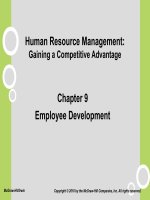Human resource management gaining a competitive advantage 9th edition test bank solutions
Bạn đang xem bản rút gọn của tài liệu. Xem và tải ngay bản đầy đủ của tài liệu tại đây (833.48 KB, 115 trang )
Human Resource Management Gaining A Competitive Advantage 9th
Edition Test Bank Solutions
Chapter 03
The Legal Environment: Equal Employment Opportunity and Safety
True / False Questions
1.
Each branch of the U.S. government (legislature, executive, and judiciary) has its own area of
authority, and these areas do not overlap.
True
2.
The United States president has the power to veto any law passed by Congress.
True
3.
False
False
The National Labor Relations Board (NLRB) is a quasi-judicial agency.
True
False
3-1
4.
Section 1982 of the Civil Rights Act granted all persons the same property rights as white citizens.
True
5.
The benefits of the Pregnancy Discrimination Act are limited to married women who are pregnant.
True
6.
False
False
Conditions such as obesity and substance abuse are covered under the Americans with Disabilities
Act.
True
7.
False
Executive Order 11478 prohibits discrimination based on race, color, religion, sex, and national origin
and applies only to federal contractors and subcontractors.
True
8.
False
The Equal Employment Opportunity Commission has three major responsibilities: investigating and
resolving discrimination complaints, gathering information, and issuing guidelines.
True
9.
False
Individuals who feel they have been discriminated against must file a complaint with the EEOC at any
time after the incident.
True
False
10. As per the Lilly Ledbetter Fair Pay Act, an "illegal act" occurs when a discriminatory compensation
decision is adopted.
True
False
3-2
11. Disparate treatment exists when individuals in similar situations are treated differently and the
different treatment is based on an individual's race, color, religion, sex, national origin, age, or
disability status.
True
False
12. In a prima facie disparate treatment case, the defendant in a disparate treatment case has the burden
of proving that the plaintiff was wrong in suing him.
True
False
13. A job qualification based on race, sex, religion, and so on, that an employer asserts is a necessary
qualification for the job is known as a bona fide occupational qualification.
True
False
14. In a mixed-motive case, the plaintiff acknowledges that some discriminatory motive existed but
argues that the same hiring decision would have been reached even without the discriminatory
motive.
True
False
15. Under the four-fifths rule, disparate treatment occurs if the hiring rate of a minority group is less than
45 percent of the hiring rate for the majority group.
True
False
16. The standard deviation rule uses the mode of the distribution to determine disparate impact.
True
False
17. Reasonable accommodation simply requires an employer to refrain from committing discriminatory
acts.
True
False
3-3
18. Under disability claims, the plaintiff must show that he/she is a qualified applicant with a disability and
that adverse action was taken by a covered entity.
True
False
19. Title VII of the Civil Rights Act of 1964 provides that employers cannot retaliate against employees for
opposing a perceived illegal employment practice.
True
False
20. Quid pro quo harassment occurs when some kind of benefit or punishment is made contingent on an
employee's submitting to sexual advances.
True
False
21. Having pictures of naked women posted in the workplace is actionable under Title VII of the Civil
Rights Act.
True
False
22. Affirmative action programs are used to eliminate discrimination in the workplace and increase
minority representation.
True
False
23. The Occupational Safety and Health Act assigned the responsibility for inspecting employers,
applying the standards, and levying fines to the Department of Health.
True
False
24. The provision of the Occupational Health and Safety Act that states that an employer has an overall
obligation to furnish employees with a place of employment free from recognized hazards is known
as the general duty clause.
True
False
3-4
25. The job hazard analysis technique is a breakdown of each job into basic elements, each of which is
rated for its potential for harm or injury.
True
False
Multiple Choice Questions
26. Which of the following amendments is called the equal protection clause?
A. Fourteenth Amendment
B. Sixteenth Amendment
C. Eighteenth Amendment
D. Twentieth Amendment
E. Third Amendment
27. Which of the following is a part of the U.S. government's executive branch?
A. District Courts
B. Committee on Indian Affairs
C. Select Committee on Ethics
D. The Congress
E. The president
28. The legislative branch of the federal government:
A. functions under the authority and supervision of the president.
B. has no say in the appointment of judges by the president.
C. consists of the House of Representatives and the Senate.
D. enforces the laws that are passed in the United States.
E. adjudicates cases pertaining to civil issues.
3-5
29. The executive branch of the federal government:
A. consists of bodies like the Select Committee on Ethics.
B. consists of the House of Representatives and the Senate.
C. adjudicates criminal cases.
D. passes laws such as the Civil Rights Act.
E. consists of the president and the many regulatory agencies the president oversees.
30. The _____ has the power to veto any law passed by Congress.
A. President pro tempore of the Senate
B. Secretary of State
C. Attorney general
D. President of the United States
E. Speaker of the House
31. Which of the following directives can be issued by the president?
A. Constitutional amendment
B. Judicial decision
C. Legislation
D. Executive order
E. Legislative bill
32. Executive order 11246, signed by President Lyndon Johnson, required all federal contractors and
subcontractors to:
A. deny payments to private contractors based on the availability of money.
B. pay taxes for the capital goods exported from other countries for operation.
C. form and implement private laws that are consistent with the constitution.
D. engage in affirmative action programs to hire and promote minorities.
E. refrain from exporting their services to projects in foreign countries.
3-6
33. Which of the following serves as the court of final appeal?
A. Circuit court
B. Supreme Court
C. Court of appeals
D. State court
E. District court
34. Which of the following amendments abolished slavery in the United States?
A. Fourth Amendment
B. First Amendment
C. Fifteenth Amendment
D. Thirteenth Amendment
E. Fourteenth Amendment
35. Which of the following is an example of a quasi-judicial body?
A. National Security Agency
B. Senate
C. Court of Appeals
D. District Court
E. National Labor Relations Board
36. If neither party is satisfied with the National Labor Relations Board's decision, the parties can take the
case to the _____ for review.
A. Court of Appeals
B. District Court
C. Senate
D. House of Representatives
E. Secretary of State
3-7
37. Section 1982 of the Civil Rights Act passed in 1886 granted all persons the _____.
A. same property rights as white citizens
B. right to carry weapons for self-defense
C. right to sue governmental authorities
D. freedom to elect members of Parliament
E. freedom from cruel and unusual punishments
38. Section 1981 of the Civil Rights Act of 1866 granted individuals the _____.
A. freedom from cruel and unusual punishments
B. right to carry weapons for self-defense
C. right to sue governmental authorities
D. right to enter into and enforce a contract
E. freedom to elect members of Parliament
39. Which of the following legislations mandates affirmative action in the employment of individuals with
disabilities?
A. Rehabilitation Act of 1973
B. Lilly Ledbetter Fair Pay Act
C. Pregnancy Discrimination Act
D. Pendleton Act
E. Civil Rights Act of 1871
3-8
40. Which of the following congressional legislations requires contractors and subcontractors that receive
more than $2,500 annually from the federal government to engage in affirmative action for individuals
with disabilities?
A. Title VII of the Civil Rights Act
B. Equal Pay Act
C. Vietnam Era Veteran's Readjustment Act
D. Vocational Rehabilitation Act
E. Pregnancy Discrimination Act
41. Which of the following states that it is illegal for an employer to refuse to hire an individual or
otherwise discriminate against this individual with respect to his compensation, terms, conditions, or
privileges of employment because of such individual's race, color, religion, sex, or national origin?
A. Unlawful Corporate Payments Act of 1977
B. Federal Employers' Liability Act
C. Executive Order 11246
D. Executive Order 1148
E. Title VII of the Civil Rights Act of 1964
42. The Age Discrimination in Employment Act of 1967 prohibits discrimination against employees over
the age of _____.
A. 30
B. 35
C. 40
D. 18
E. 15
3-9
43. Which of the following is responsible for enforcing the Age Discrimination in Employment Act?
A. Equal Employment Opportunity Commission
B. Office of Federal Contract Compliance Programs
C. U.S. Department of Commerce
D. Independent Regulatory Commission
E. U.S. Department of Labor
44. The Vocational Rehabilitation Act of 1973 is enforced by the _____.
A. Office of Federal Contract Compliance Programs
B. U.S. Department of Health
C. Equal Employment Opportunity Commission
D. U.S. Department of Commerce
E. Employment Standards Administration of the Department of Labor
45. Under the Americans with Disabilities Act of 1990, what is the damage limit for a firm that employs 14
to 100 employees?
A. $30,000
B. $150,000
C. $50,000
D. $450,000
E. $200,000
46. Which of the following is considered a disability under the Americans with Disabilities Act?
A. Cosmetic disfigurement
B. Obesity
C. Substance abuse
D. Eye color
E. Lefthandedness
3-10
47. Which of the following is a disability under the Americans with Disabilities Act?
A. Lefthandedness
B. Substance abuse
C. Eye and hair color
D. Heart disease
E. Obesity
48. Directives issued and amended unilaterally by the president are known as:
A. judicial decisions.
B. presidential vetoes.
C. presidential bills.
D. executive orders.
E. constitutional amendments.
49. Executive order 11246, which prohibits discrimination based on race, color, religion, sex, and national
origin, is enforced by the:
A. Office of Federal Contract Compliance Programs.
B. U.S. Office of Personnel Management.
C. Equal Employment Opportunity Commission.
D. United States Court of Federal Claims.
E. U.S. Department of Commerce.
50. Executive order 11478 requires the federal government to:
A. prevent reverse discrimination by abolishing affirmative action.
B. base all its employment policies on merit and fitness.
C. prevent privatization of banking and financial services.
D. base all its selections on methods such as quantitative techniques.
E. abolish personal interviews as a method of selecting federal employees.
3-11
51. The U.S. Office of Personnel Management is in charge of the:
A. executive order 11246.
B. Pregnancy Discrimination Act.
C. executive order 11478.
D. Equal Pay Act of 1963.
E. Americans with Disabilities Act.
52. Which of the following agencies is responsible for enforcing Title VII of the Civil Rights Act and the
Americans with Disabilities Act?
A. U.S. Department of Commerce
B. Equal Employment Opportunity Commission
C. Office of Federal Contract Compliance Programs
D. U.S. Department of Labor
E. U.S. Office of Personnel Management
53. Which of the following agencies is responsible for investigating and resolving discrimination
complaints, gathering information, and issuing guidelines?
A. Equal Employee Opportunity Commission
B. U.S. Department of Labor
C. Office of Federal Contract Compliance Programs
D. U.S. Department of Commerce
E. Labor Commission
3-12
54. Individuals who feel they have been discriminated against must file a complaint with the Equal
Employment Opportunity Commission (EEOC) or a similar state agency within _____ days of the
incident.
A. 30
B. 60
C. 180
D. 270
E. 365
55. After the Equal Employment Opportunity Commission (EEOC) has taken responsibility for
investigating a claim of discrimination, the complainant must give the EEOC _____ days to investigate
the complaint.
A. 30
B. 60
C. 90
D. 120
E. 180
56. Which of the following is true about how the Equal Employment Opportunity Commission (EEOC)
responds to a claim of discrimination?
A. If the EEOC determines that discrimination has taken place in a private firm, it can investigate the
discrimination but cannot file a suit.
B. If the EEOC either does not believe a complaint to be valid or fails to complete the investigation, it
issues a ruling preventing the complainant from pursuing legal action in federal court.
C. If the EEOC cannot come to an agreement with an offending employer, it can issue a "right to sue"
letter to the alleged victim.
D. If the EEOC cannot come to an agreement with an offending employer, it will collect a hefty fine
that it will pass on to the complainant.
E. If the EEOC discovers any discriminatory practice, it will urge the federal government to bar the
offending firm from doing business with federal agencies.
3-13
57. Which of the following best describes the consent decree that the Equal Employment Opportunity
Commission (EEOC) enters into with an organization that has been found to be discriminating?
A. It is a decree that permits a victim to sue the organization that has victimized him/her based on
color, religion, gender or place of birth.
B. It is a decree through which the organization agrees to furnish the details regarding the extent of
diversity amongst its staff.
C. It is a decree through which the organization accepts it has committed discrimination without
imposing any requirements to prevent discrimination in the future.
D. It is an agreement between the EEOC and the organization that the organization will cease certain
discriminatory practices.
E. It is an agreement that binds the organization to respect the rights of its employees to give consent
to the nature of conditions at the workplace.
58. Each year organizations with a minimum of _____ employees must file an EEO-1 report with the
Equal Employment Opportunity Commission.
A. 60
B. 100
C. 50
D. 80
E. 25
59. The _____ is a set of guidelines that provides guidance on the ways an organization should develop
and administer recruitment systems so as not to violate Title VII.
A. Uniform Guidelines on Employee Selection Procedures
B. Guidelines for Employment Security
C. Guidelines for Employee Facilities
D. Uniform Guidelines for Voluntary Early Retirement
E. Uniform Guidelines for Job Design and Job Description
3-14
60. Which of the following agencies or institutions is responsible for enforcing the executive orders that
cover companies doing business with the federal government?
A. U.S. District Court
B. Office of Federal Contract Compliance Programs
C. Equal Employment Opportunity Commission
D. U.S. Department of Commerce
E. Centre for Civil and Human Rights
61. The _____ compares the race, sex, and ethnic composition of an employer's workforce with that of
the available labor supply.
A. contingency analysis
B. matrix analysis
C. path goal analysis
D. differential analysis
E. utilization analysis
62. Goals and timetables in an affirmative action plan:
A. compare the race, sex, and ethnic composition of an employer's workforce with that of the
available labor supply.
B. specify the amount that an organization has spent to train an employee.
C. define whether an employee can be a member of any of the labor unions.
D. specify the percentage of women and minorities that an employer seeks to have in each job group.
E. define the minimum standards that an employee should have to be part of an organization.
3-15
63. The written affirmative plan that specifies what an employer plans to do to reduce underutilization of
protected groups is called a(n) _____.
A. utilization analysis
B. goal
C. consent decree
D. timetable
E. list of action steps
64. Which of the following is the Office of Federal Contract Compliance Programs' most potent weapon
and its last penalty?
A. Debarment
B. General warning
C. Right to sue letter
D. Class-action suits
E. Specific treatment
65. Jason, an African-American, and Robert, a Caucasian, both experienced welders, apply for two
openings at Virgo Inc. Robert is hired and Virgo continues to look for candidates to fill the other
position. Jason alleges racial discrimination by Virgo, but Virgo denies this. Which of the following
statements would both negate Jason's case and support Virgo's case?
A. Virgo deals in building equipment that requires a certified welder and Jason is a certified welder.
B. Virgo deals in building equipment that requires a certified welder and Robert is a certified welder.
C. Virgo has had a history of discrimination.
D. Virgo has never had a history of discrimination.
E. Virgo deals in building equipment that requires a certified welder and Jason is not a certified
welder.
3-16
66. Michael and Mohammad graduated from the same pilot training institute and applied for a job as a
trainee pilot at a private American airline. Despite both having similar profiles, Michael was hired but
Mohammad was not, and the airline continued to look for other potential trainee pilots. In this case,
Mohammad is a possible victim of:
A. sexual harassment.
B. quid pro quo harassment.
C. disparate treatment.
D. disparate impact.
E. racial discrimination.
67. The director of a movie auditions only white males to play the role of Abraham Lincoln in a
biographical film on Lincoln's life. This is an example of:
A. reasonable accommodation.
B. disparate treatment.
C. quid pro quo.
D. bona fide occupational qualification.
E. disparate impact.
68. In a _____ case, the defendant acknowledges that some discrimination may have occurred but
argues that the same hiring decision would have been reached even ignoring the discrimination.
A. prima facie
B. disparate impact
C. reasonable accommodation
D. quid pro quo
E. mixed-motive
3-17
69. _____ occurs when a facially neutral employment practice disproportionately excludes a protected
group from employment opportunities.
A. Disparate impact
B. Reasonable accommodation
C. Quid pro quo
D. Internal discrimination
E. Disparate treatment
70. A hotel in Florida has instituted a policy to hire individuals living in close proximity to the hotel
premises to reduce instances of employees coming in late. As the area surrounding the hotel is
predominantly populated with individuals of Hispanic origin, the Caucasian and African-American
communities became underrepresented in the hotel's workforce. This is an example of:
A. reverse discrimination.
B. disparate impact.
C. disparate treatment.
D. reasonable accommodation.
E. sexual harassment.
71. Which of the following statements is true of disparate treatment and disparate impact?
A. The discriminating individual's intent is irrelevant in disparate treatment.
B. For there to be discrimination under disparate treatment, there has to be intentional discrimination.
C. A selection practice that results in disparate impact is necessarily illegal in nature.
D. The four-fifths rule for discrimination is not applicable to disparate impact.
E. In a disparate impact case, the defendant is required to pay compensatory and punitive damages
to the plaintiff.
3-18
72. Under _____, intent is irrelevant.
A. disparate treatment
B. disparate impact
C. racial discrimination
D. gender discrimination
E. disparate discrimination
73. Which of the following rules states that an employment test has disparate impact if the hiring rate for
a minority group is less than eighty percent of the hiring rate for the majority group?
A. Standard deviation rule
B. Mixed-motive rule
C. Prima facie rule
D. Four-fifths rule
E. Business necessity rule
74. Which of the following analyses uses the difference between the expected representation for minority
groups and the actual representation to determine whether the difference between these two values
is greater than would occur by chance?
A. Utilization rule
B. Mixed-motive rule
C. Prima facie rule
D. Standard deviation rule
E. Four-fifths rule
3-19
75. According to the Civil Rights Act of 1991, once the plaintiff has made a prima facie disparate impact
case, the _____.
A. defendant is punished for engaging in discrimination
B. plaintiff is asked to present witnesses for his case
C. defendant is asked to pay punitive damages
D. burden of proof shifts to the defendant
E. defendant is freed from conviction for discrimination
76. In showing class action _____ lawsuits, the plaintiffs show some statistical disparities between the
composition of some group within the company compared to some other relevant group.
A. pattern and practice
B. disparate impact
C. disparate treatment
D. reasonable accommodation
E. quid pro quo
77. If a plaintiff feels that there are individual acts of intentional discrimination in his firm that have led to a
statistical disparity in the firm, and this disparity is a function of a larger culture of discrimination.
Which of the following lawsuits is he most likely to file?
A. Reasonable accommodation
B. Pattern and practice
C. Disparate treatment
D. Quid pro quo
E. Disparate impact
3-20
78. Which of the following refers to an organization's efforts to make usable facilities readily accessible to
individuals with disabilities?
A. Disparate treatment
B. Disparate impact
C. Reasonable accommodation
D. Pattern and performance
E. Quid pro quo
79. Which of the following acts states that employers cannot retaliate against employees for either
"opposing" a perceived illegal employment practice or "participating in a proceeding" related to an
alleged illegal employment practice?
A. Equal Pay Act
B. Fair Labor Standards Act
C. Lilly Ledbetter Fair Pay Act
D. Title VII of the Civil Rights Act of 1964
E. Vocational Rehabilitation Act
80. Jane has resisted advances from her male boss, who is interested in pursuing a sexual relationship
with her. In addition, he has been withholding her promotions for more than a year for this reason
alone. Jane can sue her boss for _____.
A. sexual harassment
B. reasonable accommodation
C. pattern and practice
D. disparate impact
E. disparate treatment
3-21
81. Jake is the manager at a restaurant and offers to promote Linda, a waitress at the same restaurant, in
return for sexual favors. This is an example of _____.
A. reasonable accommodation
B. glass ceiling
C. disparate treatment
D. prima facie
E. quid pro quo harassment
82. Anna's boss terminated her employment because she did not submit to his sexual advances. Anna is
a victim of:
A. reasonable accommodation.
B. quid pro quo harassment.
C. glass ceiling.
D. disparate impact.
E. affirmative action.
83. Saturn Inc., a large manufacturing firm, is a male dominated organization. Julia, who works for
Saturn, interacts predominantly with male employees, who frequently make sexist remarks. This is an
example of:
A. disparate treatment
B. disparate impact
C. glass ceiling
D. quid pro quo
E. hostile working environment
3-22
84. Which of the following is a form of sexual harassment that involves employees using offensive
sexually explicit language, or using sex-related jokes or innuendoes in conversations?
A. Sexual abuse
B. Quid pro quo
C. Rape
D. Domestic violence
E. Hostile working environment
85. The Occupational Safety and Health Act assigned the responsibility for inspecting employers,
applying the standards, and levying fines to the _____.
A. Department of Health
B. National Institute for Occupational Safety and Health
C. Centre for Disease Control and Prevention
D. Occupational Safety and Health Review Commission
E. Department of Labor
86. The main provision of the Occupational Safety and Health Act states that each employer should
furnish each employee a place of employment free from recognized hazards that cause or are likely
to cause death or serious physical harm. This is referred to as the:
A. general duty clause.
B. employer clause.
C. employee clause.
D. first aid clause.
E. national consensus clause.
3-23
87. Bloom Corp. is a firm whose workers work in an old facility; its employees request a government
inspection to ensure that they are not exposed to any hazardous materials while working in the
facility. Which of the following acts gives them the right to do so?
A. Rehabilitation Act
B. Civil Rights Act
C. Occupational Safety and Health Act
D. Equal Pay Act
E. Title VII of Civil Rights Act
88. The Occupational Safety and Health Act requires employers to keep records of deaths, injuries, and
illnesses if they have _____ or more full-time or part-time employees.
A. 100
B. 50
C. 51
D. 11
E. 25
89. The _____ breaks down each job into basic elements and rates each of the elements for its potential
for harm or injury.
A. technic of operations review
B. domino analysis
C. multilinear events sequencing
D. change analysis
E. job hazard analysis technique
3-24
90. The _____ is an analysis methodology that helps managers determine which specific element of a job
led to a past accident.
A. domino analysis
B. technic of operations review
C. job hazard analysis technique
D. multilinear events sequencing
E. change analysis
Essay Questions
91. Discuss the roles and responsibilities of the legislative branch, the executive branch, and the judicial
branch.
92. Discuss the three major responsibilities of the Equal Employment Opportunity Commission.
3-25









